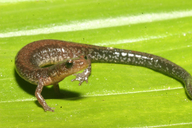|
Plethodon sherando Highton, 2004
Big Levels Salamander Subgenus: Plethodon | family: Plethodontidae subfamily: Plethodontinae genus: Plethodon |
| Species Description: Highton R 2004 A new species of woodland salamander of the Plethodon cinereus group from the Blue Ridge Mountains of Virginia. Jeffersoniana 14:1-22. | |
 © 2006 Richard D. Bartlett (1 of 9) |
|
|
|
Description Within the Plethodon genus, P. sherando is most similar to P. cinereus and P. serratus in appearance. These three species all have gray and white ventral pigmentation, but P. sherando has more white pigmentation than gray while P. cinereus and P. serratus have a more even split of the two colors. Additionally, all three have a dorsal red stripe, but P. sherando has less pigment in its stripe than the other two. Plethodon sherando also has a wider head and longer legs than P. cinereus as well as fewer costal grooves between the toes of the adpressed limbs (Highton 2004). There are fewer trunk vertebrate in P. sherando than in P. cinereus (Bayer et al. 2012). In life, the salamander had gray/white ventral pigmentation and a red dorsal stripe with straight edges and brassy flecks on the inside and outside of the stripe. On top of the head, behind the snout, there is a red “V” with the apex pointing in the anterior direction. About half of the chin has a yellow pigmentation. Small white spots and brassy flecks are on top of the head, the eyelids, and the legs, and brassy flecks occur on dorsal side of legs. The pigmentation of the upper iris of the eye is a brassy color (Highton 2004). There was variation in the presence of the red dorsal strip in P. sherando. Specimens without the red dorsal stripe are similar to the ones with a stripe except they lacked red pigment and have reduced yellow lateral pigmentation (Highton 2004). Distribution and Habitat Country distribution from AmphibiaWeb's database: United States U.S. state distribution from AmphibiaWeb's database: Virginia
Life History, Abundance, Activity, and Special Behaviors Because of its longer limbs and a larger head, it is able to access areas that others in this genus may not be able to access. This is an advantage in terms of accessing small crevices within rocks, but more limiting when encountering areas that are dominated by areas with finer substrate (Farallo and Miles 2016). In lower elevations, other Plethodon salamanders can be found, but in the medium and high elevations, only P. sherando are found (Highton 2004). In several sites, P. sherando and P. cinereus have range overlaps and may have a low rate of hybridization (Bayer et al. 2012). Trends and Threats Possible reasons for amphibian decline Habitat modification from deforestation, or logging related activities Comments Bayesian Inference and Maximum Likelihood Analysis of sequence data from two mitochondrial regions (cyt-b and CO1) and morphological analysis from two contact zones show that, despite having a geographic range overlap and hybridizing with P. cinereus, the two are highly divergent. Instead P. serratus has been identified as the sister species to P. sherando, with the P. hubricti being the next most closely related species followed by P. shenandoah, then P. cinereus. Furthermore, genetic divergence from P. cinereus and other nearby Plethodon and distance from P. serratus’ current range, indicated that P. sherando is a distinct lineage that has a history of geographic isolation and is not influenced hybridization with P. cinereus (Bayer et al. 2012). The species epithet, sherando comes from Sherando Lake in George Washington National Forest, which is named after an Iroquois Indian chief who lived in the Shenandoah Valley and is one of the main areas of this species range (Highton 2004).
References
Bayer, C.S.O., Sackman, A.M., Bezold, K., Cabe, P.R., Marsh, D.M (2012). ''Conservation genetics of an endemic mountaintop salamander with an extremely limited range.'' Conservation Genetics, 13(2), 443-454. [link] Farallo, V.R., Miles, D.B. (2016). ''The importance of microhabitat: a comparison of two microendemic species of Plethodon to the widespread P. cinereus.'' Copeia, 104(1), 67-77. [link] Highton, R. (2004). ''A new species of woodland salamander of the Plethodon cinereus group from the Blue Ridge Mountains of Virginia.'' Jeffersonia, 14, 1-22. [link] Highton, R., Collins, J. (2006). ''Plethodon sherando''. The IUCN Red List of Threatened Species 2006: e.T61905A12569864. http://dx.doi.org/10.2305/IUCN.UK.2006.RLTS.T61905A12569864.en. Downloaded on 12 December 2018. [link] Originally submitted by: Angela Trenkle (first posted 2019-02-18) Edited by: Ann T. Chang (2019-02-18) Species Account Citation: AmphibiaWeb 2019 Plethodon sherando: Big Levels Salamander <https://amphibiaweb.org/species/6354> University of California, Berkeley, CA, USA. Accessed Apr 18, 2024.
Feedback or comments about this page.
Citation: AmphibiaWeb. 2024. <https://amphibiaweb.org> University of California, Berkeley, CA, USA. Accessed 18 Apr 2024. AmphibiaWeb's policy on data use. |




 Raffaëlli Account
Raffaëlli Account Map of Life
Map of Life